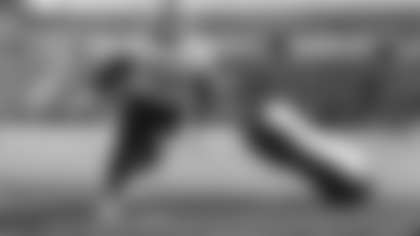This will be the fourth straight week for the Bills in which they face an effective 3-4 defensive front. Buffalo's offense had success against San Diego, but has had more than its share of struggles in executing effectively the past two weeks facing the Dolphins and the Jets. The Bills are hoping to change that trend against New England.
"You have to study and that is what our division is," said offensive coordinator Turk Schonert. "They are a match-up zone and may send some man coverage teams, pressure team. The Jets pressured us and we were open downfield. We had some opportunities to get some big plays. We missed, we missed some throws, and we ran the wrong route. Our protection didn't hold up a couple of times and guys were open downfield for big plays."
One missed opportunity was on the first play of the game last Sunday. James Hardy beat the safety on a double move, but pass pressure forced Trent Edwards to check down.
"We had Hardy twice deep, one maybe two touchdowns, didn't get the ball off, we got pressured," said Schonert. "We take shots, we call them, but they might not get thrown because we don't protect it long enough and that is what happened. First play of the game we had to dump it off to Marshawn (Lynch). We had another one in the corner of the end zone that we had to dump off to Corey (McIntyre) because we got pressure. We have to protect a little better and we have to run the football better."
After being stymied in the run game last week, Buffalo has fallen to 26th in the league in rushing. As a team they've averaged 3.6 per carry. Marshawn Lynch has managed just 3.5 per carry, almost a full half yard less per rush than he had through eight games last season.
The Bills have cracked 100 yards rushing as a team two of the last three weeks, but have also fallen below their season rush per carry average (3.6) in two of the last three games as well. All of those games have been against 3-4 defensive fronts, which have been dead set on keeping Lynch and Fred Jackson from bouncing runs outside.
"It's tough because those outside linebackers are very active," said Edwards. "Facing the Dolphins, then facing those guys last week against the Jets they are containing the outside run game and forcing you back into the middle where the nose tackles the last two weeks have been the strengths of the last two defenses. That's why teams run that 3-4, to try and keep the run game inside. Don't let the speed get to the outside and funnel it into the strength of their defense."
Unfortunately New England has the same strength with a defensive line that features three former first-round draft picks. Outside linebackers Mike Vrabel and Adalius Thomas are good at the point of attack and hem in backs on outside run plays allowing the big men inside to clean up on the play.
In an effort to better disguise whether they're going to run or pass, Edwards has spent a lot of time watching his movements to make sure he's not giving the opposing defense any hints as to what's coming.
"(I'm) making sure I'm not tipping off my runs, making sure my footwork and my mechanics are similar on both pass and run plays and not trying to show anything," said Edwards. "If there's anything that they are learning from formations or snap points or little tips here and there I've been trying to look at that. Obviously the best way to get the running game going is to have an effective passing game to keep defenses on their toes and keep them guessing. I need to be able to do that too to help out the running game."
The only problem is the opposing defenses the past two weeks have found that they can commit to coverage, not get hurt underneath and get pressure on Edwards. Miami and New York both got effective pressure with three and four man rushes, allowing them to commit seven or eight players to coverage.
With the safeties playing a good amount of two deep the targets in the passing game are fewer and further between, forcing Edwards to wait a bit longer before delivering the ball. That in turn allows the three or four man pressures to become even more effective.
Missing their best underneath receiving option in Josh Reed and lacking a run game that can make a seven-man front pay most of the time, finding consistency has become more difficult for Buffalo's offense the past few weeks.
"That's obviously a big, big issue that we need to run a balanced attack, we need to keep their defense guessing," said Edwards. "We need to stay out of those long down and distances and without getting positive yardage with the running game, they know we're going to have to pass the ball. It's tough to be in that position, it affects your passing game. Once our running game gets going, we'll get the passing game going a little more, too."
New England, however, can create a lot of the same problems for Buffalo's run game as their two previous division opponents.
"They're still really aggressive," said Edwards. "Their safeties are really active, I think that they sit back in zones and allow their pass rush to get to the quarterback. They disguise things really well, much like the Jets did last week. They rely a lot upon their front three to get to the quarterback. Their linebackers are pretty solid as well. They're secondary shows a lot of different looks and I'm pretty sure they'll do the same this Sunday, too."
Ultimately, Buffalo must find a way to run the football more effectively and hurt the Patriots on some plays in the pass game to dictate play instead of being forced to react to their opponent.
"We have to keep working through it, keep learning and film study," said Schonert. "New England plays the same way. They are a physical, veteran, match-up team that plays with great technique and great intensity. We have to match their intensity and their technique."





